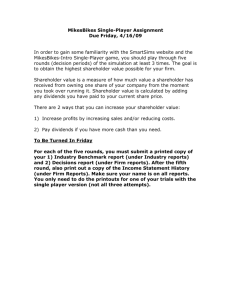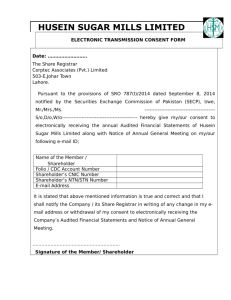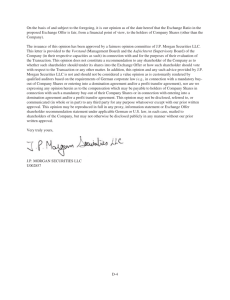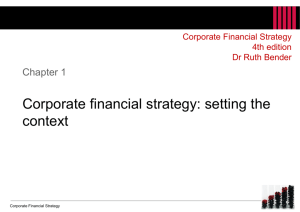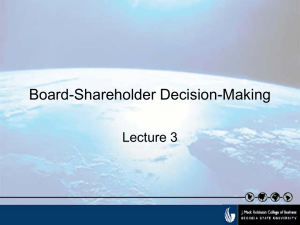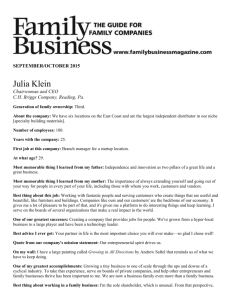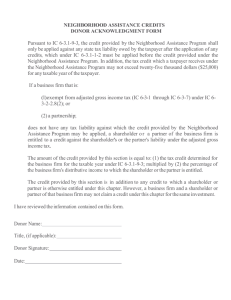ISO's Vision Statement - Casualty Actuarial Society
advertisement
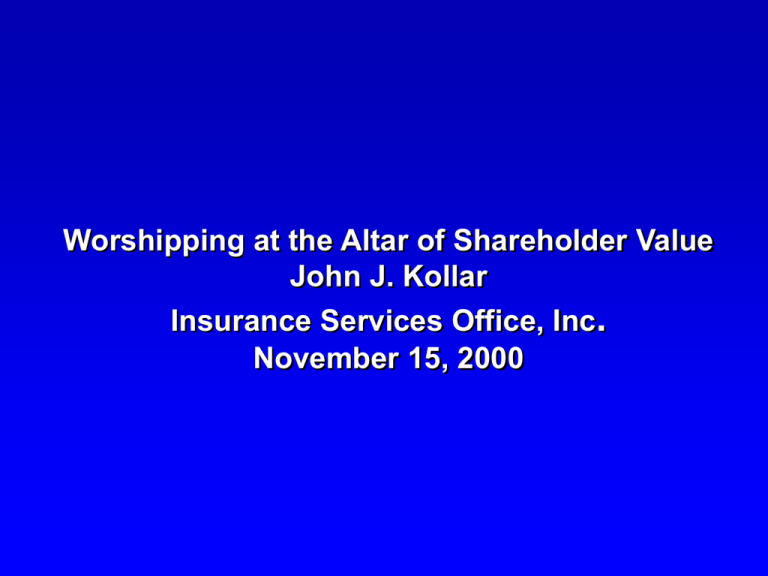
Worshipping at the Altar of Shareholder Value John J. Kollar Insurance Services Office, Inc. November 15, 2000 Information herein is believed to be reliable but J.P. Morgan does not warrant its completeness or accuracy. Opinions and estimates constitute our judgment and are subject to change without notice. Past performance is not indicative of future results. This material is not intended as an offer or solicitation for the purchase or sale of any financial instrument. J.P. Morgan and/or its affiliates and employees may hold a position or act as market maker in the financial instruments of any issuer discussed herein or act as underwriter, placement agent, advisor or lender to such issuer. J.P. Morgan Securities Inc. is a member of SIPC. This material has been approved for issue in the UK by J.P. Morgan Securities Ltd. which is a member of the London Stock Exchange and is regulated by the SFA. 2000 J.P. Morgan & Co. Incorporated. Clients should contact analysts at and execute transactions through a J.P. Morgan entity in their home jurisdiction unless governing law permits otherwise. For research to private clients in the U.K.: The investments and strategies discussed herein may not be suitable for all investors, if you have any doubts you should consult your investment advisor. The investments discussed may fluctuate in price or value. Investors may get back less than they invested. Changes in rates of exchanges may have an adverse effect on the value of investments. Weston M. Hicks • Managing Director @ J.P. Morgan Securities, Inc. – equity research of p/c, health, multiline insurers • Senior Research Analyst @ Sanford C. • Bernstein & Co, Inc. Fixed income Securities @ Moody’s Investors Service • Commercial Banker @ Bank of America & • Chase Auditor @ Peat, Marwick Mitchell & Co. Weston M. Hicks (Cont’d) • BS in Business & Economics from Lehigh • • • • • University CFA, CPA First place for last 7 years on Institutional Investor’s All-American Research Team Top P/C Analyst in 2000 by Reuters & the Street.com Member of New York Society of Security Analysts Past President of Association of Insurance & Financial Analysts David B. Kelso • Executive Vice President & Chief Financial Officer, @ The Chubb Corporation/Chubb & Sons, Inc. – applies broad corporate strategy to all financial decisions and actions • Member of Policy Committee - business planning, resource allocation, corporate finance, mergers & acquisitions, treasury, tax, accounting, internal audit, IT, actuarial David B. Kelso (Cont’d) • CFO & Head of Retail Banking @ First Commerce Corporation • Partner and Head of North American Financial Service Practice of Gemini Consulting • Corporate Lending Officer @ Chemical Bank • BA from Princeton University • MBA from Darden School, University of Virginia Stephen P. Lowe • Principal and Consulting Actuary @ Tillinghast - Towers Perrin – manager of global product/ service development – actuarial analyses – strategic planning – economic value measurement – stochastic models to measure and manage risk and capital – exposure management Stephen P. Lowe (Cont’d) • Casualty and corporate actuarial departments @ Aetna • BS in mathematics from Union College • FCAS • Member of CAS Board • Active in CAS & AAA Shareholder Value • Key components • Property/casualty industry performance – review – outlook Property/Casualty Industry - Some Other considerations • Cyclicality of results • Regulation - solidity/solvency • Mutuals/reciprocals Convergence of Financial Services Industries • Gramm-Leach-Bliley Financial Services Reform Act – removed legal barrier between insurers, banks and securities firms – regulation Globalization • Customers • Insurers/reinsurers • Free trade Property/Casualty Risk Securitization • General growth in derivative markets • Catastrophe bonds/options • Tokyo Disneyland catastrophe bonds sold directly to financial markets • NAIC securitization studies Information Technology Risk Assessment • Catastrophe models • DFA models Business to Business (B2B) • Communication • Information • Viruses Marketing/Distribution • Internet Risk is Risk • Enterprise Risk Management • Capital management “Worshipping At The Altar of Shareholder Value” Weston M. Hicks J.P. Morgan Securities November 15, 2000 Overview • Shareholder value - what is it, why is it important? • The scorecard: how is the propertycasualty industry doing • Industry review and outlook What is meant by “shareholder value?” Shareholder value is the long-term (3-5 year) growth in the value of the business What shareholder value isn’t Short-term earnings trends Premium growth Size of the company Stature within the industry Why shareholder value matters • Shareholder value drives share performance over time • A rising share price allows a company to attract & retain talent • Opportunities may arise that require low cost of capital • Investors don’t have to invest in the property-casualty industry! Annualized Total Return (11/95-10/00) 30 20.98 20 11.48 10 0 S&P 500 S&P P&C Annualized Total Return (11/95-10/00) 39.50 40 36.75 28.73 30 20.98 20 10 0 S&P 500 MMC AIG HIG Annualized Total Return (11/95-10/00) 40 28.86 30 23.47 20.98 20 16.43 14.13 10 0 S&P 500 ACL XL SPC CB Annualized Total Return (11/95-10/00) 40 30 20.98 17.82 20 16.64 11.78 10 0 -3.83 -10 S&P 500 PGR ALL MCY SAFC Year-to-Date Appreciation 59.13 60 47.49 50 40 30 20 10 0 -10 -2.19 -20 S&P 500 S&P P&C S&P Multiline Property Casualty Insurance Industry Trends Long Term Trends In Capitalization 1980 1990 2000 Premiums $94 $215 $300 Reserves 92 290 365 Surplus 52 136 330 ($ billions) Long Term Trends In Capitalization 1980 1990 2000 NPW/surplus 1.8x 1.6x 0.9x Reserves/surplus 1.8x 2.1x 1.1x Capacity utilization 95% 95% 50% Excess Capital is in Both Personal Lines and Commercial Lines Personal Commercial Adj premium 113 183 Adj capital 112 160 Req'd capital 57 112 Excess 55 38 Industry Cash Flow is at a Bottom 30% % Change Net Written Premium 25% Cash Flow as a Percentage of Premiums 20% 15% 10% 5% Year 2000 1998 1996 1994 1992 1990 1988 1986 1984 1982 1980 1978 1976 1974 1972 1970 1968 1966 1964 0% Paid to Incurred Ratios at All Time Highs 50% 40% 35% 30% 25% 20% 15% 10% 5% Industry Personal Auto Workers Comp Comm'l Auto General Liability CMP 1999 1998 1997 1996 1995 1994 1993 1992 1991 1990 1989 1988 1987 1986 1985 1984 1983 1982 0% 1981 intial paid to incurred ratio 45% Catastrophes are a Growth Market $35.0 $30.0 Global Insured Catastrophe Losses in Current Dollars $25.0 $20.0 $15.0 $10.0 $5.0 Insured Catastrophe Losses 10 Yr. Average 1998 1996 1994 1992 1990 1988 1986 1984 1982 1980 1978 1976 1974 1972 1970 $0.0 Estimated ROI on 2000 Accident Year Standard Comm'l Specialty Comm'l Personal Auto CR 120% 106% 104% Investment Return 7.5% 7.5% 7.5% Leverage 1.5x 1.0x 2.0x -0.2% 10.4% 5.4% ROI Summary • Yesterday’s strategy of holding strong capital position and waiting for “hard market” unlikely to work • Companies that have found profitable growth opportunities have been the value creators (AIG and HIG in particular) • Excess industry capital likely to cap the upside in current cycle “Worshipping at the Altar of Shareholder Value David B. Kelso Chubb Corporation and Chubb & Son November 15, 2000 In the areas of profitability and growth, the P & C industry has shown mixed results Agency Companies Direct Writers 1995 - 1999 90 18 Travelers 14 CHUBB AIG Hartford GEICO St. Paul 12 Allstate 10 Progressive Safeco 8 6 CNA GEICO 95 4 State Farm USAA 2 Farmers Combined Ratio (%) Operating Ratio (%) 16 Progressive Allstate 100 AIG 105 State Farm 110 CHUBB Safeco Farmers Hartford USAA St. Paul Travelers CNA 115 0 -10 120 -5 0 5 10 15 20 NWP Growth (%) Source: A.M. Best Company, company statements * 12-quarter average, weighted by NPW, ending 12/31/99 25 -10 -5 0 5 10 NWP Growth (%) 15 20 25 Earnings growth is a major driver of stock price Value Migration in Insurance (1999)* AIG (5.03) 4.5 4.0 3.5 Citigroup Value Inflow Danger Point 3.0 Market Value Book Value Jefferson – Pilot Cigna 2.5 Protective 2.0 Progressive Lincoln CHUBB Travelers 1.5 Conseco Torchmark St. Paul Stability Frontier (-43%) Enhance Capital Re Selective Transatlantic Safeco 1.0 0.5 Value Outflow 0.0 50% 40% High Growth 30% 20% Net Income Growth (1990-1999 CAGR) 10% UNUM (-48%) CNA (-50%) Fremont (-61%) Trenwick (-32%) 0% -10% Low Growth *1999 data used unless otherwise noted; Capital Re net income growth is 1990-1998 and MV/BV is based on 1998 figures. Net Income growth for Travelers and Fremont are from 1995 to 1999. Source: Compustat, Mercer analysis, Marketwatch. Earnings stability is another, ... Volatility of Earnings EPS Growth Rates 5Y 3Y 2Y CV* of Growth Rates 5Y 3Y 2Y Market - To - Book 1994 1996 1999 AIG 15.0% 13.8% 12.9% 0.15 0.15 0.15 1.5-2.0 1.8-2.5 3.4-4.9 XL 16.2% 14.1% 7.3% 0.62 0.90 0.90 1.1-1.5 1.2-1.7 0.9-1.8 Travelers 17.4% 17.4% 10.4% 0.70 0.70 0.22 N/A 1.4-2.3 1.0-1.7 CNA 380.4% 575.3% 871.0% 2.16 1.90 1.57 0.8-1.2 0.8-1.1 0.6-1.0 ACE -114.4% 1.0% -6.8% (2.38) 23.62 (3.95) 0.9-1.4 0.9-1.6 0.7-1.8 CHUBB 4.8% -1.8% -8.8% 3.09 (7.10) (0.49) 1.4-1.7 1.3-1.9 1.2-2.2 Safeco -6.9% -21.3% -32.0% (3.55) (0.90) (0.23) 1.0-1.4 St Paul 9.5% 17.7% 9.7% 4.41 3.16 *CV is the coefficient of variation for EPS growth rates. 7.87 0.9-1.3 0.6-1.2 1.1-1.5 1.0-1.3 0.8-1.3 . . . And return - on - equity is a third Financial Services Value Map (1999)* Reinventors Capital One (6.27) American Express (7.37) Schwab (13.8) 6.0 T. Rowe Price First Data AIG 5.0 State Street 4.0 Citigroup Market Value Innovative Business Designs AFLAC Book Value Wells Fargo 3.0 Cigna Under Performers 2.0 Frontier (-8.36) UNUMProvident 1.0 Fremont Trenwick -1.0 -0.5 0.0 0.0 CNA Jefferson – Pilot Protective United Healthcare Progressive First Union Lincoln Torchmark B of A CHUBB Travelers Conseco Capital Re St. Paul Allstate Enhance Countrywide Safeco Selective Transatlantic 0.5 1.0 1.5 2.0 Chase Manhattan Companies with Potential Unrecognized Value 2.5 3.0 3.5 Return Over Cost of Capital (ROE/Ke) *1999 data used unless otherwise noted; Capital Re ROE is based on 1998 data. Frontier’s stock price hit a new 52 week low on 4/17/00. Note: The S&P cost of capital of 10% was used for all companies. Source: Compustat, Mercer analysis, Marketwatch. Growth alone does not create superior performance . . . Implied Market-to-Book Ratio E.P.S. Growth Rate 11% 0% 1.0 2% 1.0 4% 1.0 6% 1.0 8% .9 10% .9 12% .8 13% 1.2 1.1 1.2 1.2 1.2 1.4 1.4 15% 1.2 1.3 1.3 1.4 1.6 1.8 2.0 17% 1.4 1.4 1.5 1.7 1.9 2.2 2.4 19% 1.5 1.6 1.7 1.9 2.2 2.7 3.1 R.O.E. Source: Benjamin Branch and Bradley Gale, “Linking Corporate Stock Price Performance to Strategy Formulation”; this study analyzed the drivers of market-to-book of 600 companies over 14 years. . . . Particularly in an excessively overcapitalized industry U.S. P&C Industry is Overcapitalized by Approximately 20-34% Economic Capital vs. Available Capital $500BN $422 BN $400 $353 BN $315 BN $300 $200 $100 $0 Economic Capital at "A” S&P Solvency Standard Economical Capital at "AA” S&P Solvency Standard Available Capital © 2000 Oliver, Wyman & Company, eRisks, and Risk Management Solutions, Inc. Note: Moody’s estimates, however, that the industry’s shortfall in reserves total $261 million, or 4.2%. Worshipping at the Altar of Shareholder Value Stephen P. Lowe Tillinghast - Towers Perrin November 15, 2000 I will be covering three topics... 1 Viewpoint on shareholder value 2 Why focus on shareholder value? 3 Trends in the use of shareholder value measurement 1 Shareholder value is a measure of the total value of an enterprise to Actual Proxy its owners shareholder value shareholder value = Current equity + Present value of future free cash flows -distributable profits 1 Key characteristics of a PV-FCF proxy measure of shareholder FUTURE DISCOUNT CAPITAL EXPERIENCE RATE value Future cashflows projected using “best estimate” assumptions Projections allow for regulatory & working capital requirements Present values determined using a market-based risk discount rate PV-FCF VALUE MEASURE 1 Actual shareholder value and proxy PC-FCF value can be related External Market Market Value • Observable in capital market • Risk (b) estimable Internal Economic Embedded Value • Existing customers • Measured using validated assumptions 2 No conventional financial performance Percentage of Enterprise Valueshareholder Explained indicator explains value very well 35 30 25 % 20 15 10 5 0 Sales EPS Cash flow EVA growth growth growth ROE Source: Seabury analysis 10/98 Sample data include all insurance (Life and General) companies analysed by Valueline 2 Value-based performance is critical when the business involves an up-front • In property/casualty investment – New business expense is higher than renewal – Loss ratiosNew improve asInitially business “seasons” Business is Unprofitable – Retention rates are key to value creation Alignment of the interests of management with the interests of shareholders Behavioral Implications of 2 Measures ROE EVA EARNINGS • Grow • Improve ROE without • Focus only on regard to • highest ROE product line Forego growth• that lowers average ROE capital required No credit for balance sheet manageme nt • Grow earnings and minimize capital -- forego growth -- milk assets • Ignore dividends TOTAL SHAREHOLDE R RETURN • Understand risk, return and growth • Responsible for managing all factors • Most useful for target setting and benchmarks 3 Current state of play Funds Management Life Insurance P/C Insurance Publication in accounts/ analyst compendiums Internal management M&A activities “The Times They Are A - Changin’ ” - Bob Dylan
